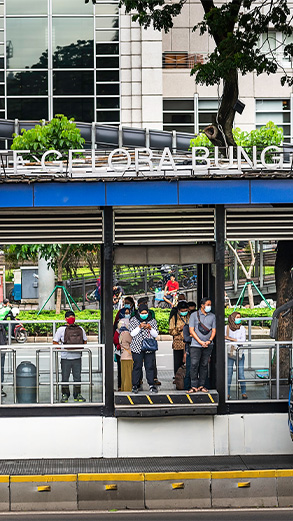Countries:
Indonesia
Status:
Completed
Sector:
Mobility
Delivering a robust regulatory framework and alternative financing schemes to enable the acceleration of e-bus scale-up across Jakarta and Indonesia
Transjakarta, a rapid bus transit system in Jakarta, committed to electrifying its fleet of vehicles by 2030. Their goal faced barriers to investment opportunities due to the lack of regulatory precedent, higher up-front costs, and the technological complexity. Furthermore, there were challenges in the financial capacity of the operators under Transjakarta’s contract.
In the first year of support from UK PACT, ITDP developed a comprehensive scale-up plan and an electrification road map and timetable document to deploy electric microbuses by 2030. They also developed policy recommendations to remove barriers and support electric bus deployment in Jakarta.
In Phase II of the project, ITDP aimed to create enabling conditions for the implementation of e-bus fleets, initiating the first phase of bus electrification. These conditions included a strong regulatory framework for bus electrification and a final business case to increase access to financing. ITDP also aimed to provide additional technical assistance for implementation strategies and capacity building so stakeholders had the tools to continue making progress on electrification goals past the end of the project date.
As a result of this project, Transjakarta and the Government of Jakarta now have alternative financing schemes and business models – along with a robust regulatory framework to help accelerate the acquisition of e-bus fleets to reach the target of 10,000 e-buses by 2030.
“We really appreciate the work. It’s not only applicable for microbuses, but also helpful for the big buses as well.”
Yoga Adiwinarto
Director of Operational and Safety of Transjakarta
“Your work is very helpful. Without your analysis on the financing mechanism, I think we would only be going round in circles with Transjakarta. Hopefully, Transjakarta can now start processing these alternative financing mechanisms.”
Richard Michael
Country Head Indonesia of UK Export Finance

for large-scale electrification of Transjakarta through to 2030, including an investment plan
comparing the costs of diesel and electric buses, allowing Transjakarta choose the most cost-effective route
developed as alternative solutions that Transjakarta can implement to support the electrification
providing a robust regulatory basis for large-scale electrification through a Governor Decree
Over the course of two years, ITDP developed outputs and processes to facilitate Transjakarta’s electrification. Key achievements included:
through focus group discussions, interviews and surveys to ensure their needs and opinions were included in the design
to increase accessibility and safety for marginalised users
from an updated tariff structure, to improved accessibility at bus stations
of the regulatory framework for Jakarta’s e-buses
ITDP ensured mainstreaming of GESI activities throughout the project to ensure that all groups had access to future jobs and use of public transportation without being negatively impacted throughout the electrification. Some of the GESI outputs across the two years included:

ITDP identified some key lessons and recommendations throughout the two years of implementing this project:
UK PACT (Partnering for Accelerated Climate Transitions) is a unique capacity-building programme. Jointly governed and funded by the UK Government’s Foreign, Commonwealth and Development Office (FCDO) and the Department for Energy Security and Net Zero (DESNZ) through the UK's International Climate Finance, it works in partnership with countries with high emissions reduction potential to support them to implement and increase their ambitions for tackling climate change.
© Copyright 2025 UK PACT Privacy Notice Cookie Policy